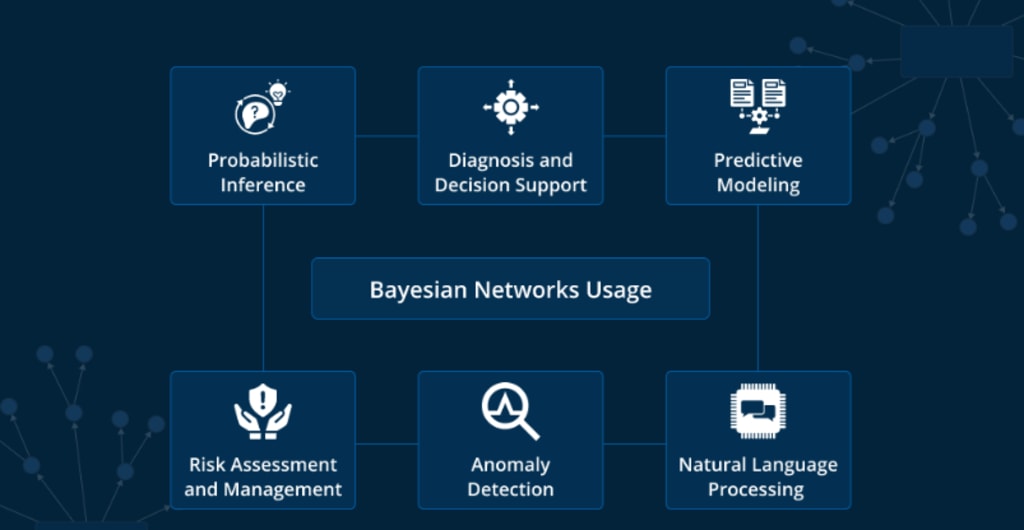Content warning
This story may contain sensitive material or discuss topics that some readers may find distressing. Reader discretion is advised. The views and opinions expressed in this story are those of the author and do not necessarily reflect the official policy or position of Vocal.
Bayesian Networks in AI
Decoding the Power of Bayesian Networks: A Journey into AI's Probabilistic Realm

Artificial Intelligence (AI) has revolutionized various industries, and one of the key techniques used in AI is Bayesian Networks. These powerful tools enable us to model uncertainty and make informed decisions based on probabilistic reasoning. In this article, we will delve into the world of Bayesian Networks, exploring their structure, applications, advantages, and challenges.
Introduction to Bayesian Networks in AI
Bayesian Networks are a type of probabilistic graphical model that represents relationships between random variables. They have found extensive use in AI and machine learning due to their ability to handle uncertainty and perform reasoning under incomplete information.
Understanding the Basics of Bayesian Networks
What are Bayesian Networks?
At their core, Bayesian Networks are a way of representing causal relationships between different events or variables in a directed acyclic graph (DAG). Nodes in the graph represent random variables, and edges represent conditional dependencies.
Key Components of Bayesian Networks
The fundamental components of Bayesian Networks include nodes, edges, and conditional probability tables (CPTs). Nodes represent variables, edges indicate the relationships between variables, and CPTs define the conditional probabilities of each variable given its parent variables.
Probabilistic Graphical Models
Bayesian Networks fall under the category of probabilistic graphical models. These models use graphs to represent complex probabilistic relationships between variables, providing a visual and intuitive way to understand the underlying structure.
The Structure of Bayesian Networks
Nodes and Directed Acyclic Graphs (DAGs)
The structure of a Bayesian Network is based on a DAG, where the absence of cycles ensures efficient inference. Each node in the graph represents a random variable, and the arrows between nodes denote causal relationships.
Conditional Probability Tables (CPTs)
CPTs hold the conditional probabilities for each node given its parent nodes. These probabilities are essential for performing probabilistic inference in Bayesian Networks.
D-Separation and Independence
D-Separation is a concept used to determine conditional independence between nodes in a Bayesian Network. Understanding this notion is crucial for accurate reasoning.
Inference and Learning in Bayesian Networks
Exact Inference
Exact inference in Bayesian Networks involves calculating probabilities using exact methods like variable elimination or belief propagation.
Approximate Inference
Approximate inference methods, such as Markov Chain Monte Carlo (MCMC), are used when exact inference becomes computationally infeasible for large networks.
Learning the Structure and Parameters
Bayesian Networks can learn their structure and parameters from data, making them adaptable to different domains and applications.
Applications of Bayesian Networks in AI
Medical Diagnosis
Bayesian Networks have shown remarkable success in medical diagnosis by handling uncertain medical data and providing accurate predictions.
Fraud Detection
In the financial sector, Bayesian Networks are utilized to detect fraudulent activities by modeling patterns of fraudulent behavior.
Natural Language Processing
Bayesian Networks are also applied in natural language processing tasks, such as language modeling and sentiment analysis.
Advantages and Challenges of Bayesian Networks
Interpretability
Bayesian Networks offer a clear and interpretable representation of probabilistic relationships between variables, making them useful in domains where understanding the decision-making process is crucial.
Handling Uncertainty
These networks can effectively handle uncertainty and incomplete information, a critical aspect in real-world scenarios.
Data Requirements
One of the challenges of Bayesian Networks is the need for a significant amount of data to learn accurate structures and parameters.
Comparison with Other AI Techniques
Bayesian Networks vs. Neural Networks
Bayesian Networks excel in handling uncertainty and providing transparent reasoning, while neural networks are more suitable for complex pattern recognition tasks.
Bayesian Networks vs. Decision Trees
Both techniques have their advantages, with Bayesian Networks being more expressive and flexible in modeling dependencies.
Real-World Examples of Bayesian Networks in AI
Google's PageRank Algorithm
Google's famous PageRank algorithm, used to rank web pages in search results, is based on the principles of Bayesian Networks.
Speech Recognition Systems
Bayesian Networks play a crucial role in modern speech recognition systems, enabling accurate and context-aware speech understanding.
The Future of Bayesian Networks in AI
As AI continues to evolve, Bayesian Networks are likely to find even more applications in diverse fields, given their ability to handle uncertainty and model complex relationships.
Conclusion
Bayesian Networks are a powerful tool in the realm of AI, offering a structured and probabilistic approach to problem-solving. Their applications span across various industries, from healthcare to finance and natural language processing. As AI advances further, Bayesian Networks will continue to play a vital role in shaping the future of intelligent systems.
About the Creator
Enjoyed the story? Support the Creator.
Subscribe for free to receive all their stories in your feed. You could also pledge your support or give them a one-off tip, letting them know you appreciate their work.





Comments (1)
I'm so grateful to have found https://www.cp-investigation.com when I was scammed by this fraudulent broker. They provided me with the support and resources I needed to recover my lost funds, and they did it quickly and efficiently. The customer service was top-notch, and they gave me the assurance that my money was in safe hands. If you ever find yourself in a similar situation, I highly recommend reaching out to cp-investigation as they are trustworthy and reliable partners.